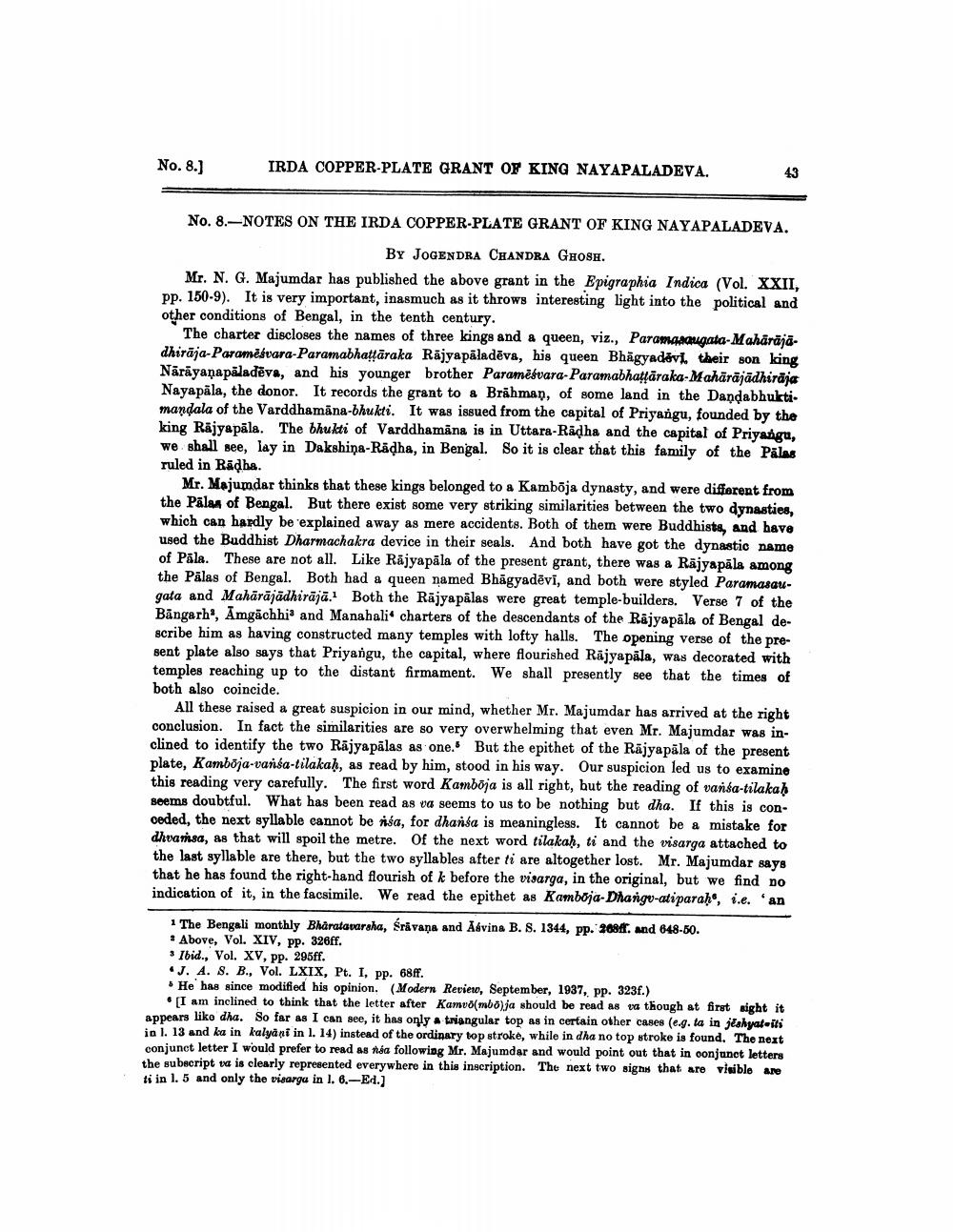________________
No. 8.)
IRDA COPPER-PLATE GRANT OF KING NAYAPALADEVA.
No. 8.-NOTES ON THE IRDA COPPER-PLATE GRANT OF KING NAYAPALADEVA.
BY JOGENDRA CHANDRA GHOSH. Mr. N. G. Majumdar has published the above grant in the Epigraphia Indica (Vol. XXII, pp. 150-9). It is very important, inasmuch as it throws interesting light into the political and other conditions of Bengal, in the tenth century.
The charter discloses the names of three kings and a queen, viz., Paramgaaugata Maharājā. dhiraja-Paramèsvara-Paramabhatļāraka Räjyapāladēva, his queen Bhagyadovi. their son king Nārāyanapaladēva, and his younger brother Paramėsvara-Paramabhatļāraka-Mahārājādhiraja Nayapāla, the donor. It records the grant to a Brāhman, of some land in the Dandabhuktimandala of the Varddhamana-bhukti. It was issued from the capital of Priyangu, founded by the king Rajyapala. The bhukti of Varddhamana is in Uttara-Radha and the capital of Priyangu, we shall see, lay in Dakshiņa-Rādha, in Bengal. So it is clear that this family of the Palas ruled in Radha.
Mr. Majumdar thinks that these kings belonged to a Kamboja dynasty, and were different from the Palan of Bengal. But there exist some very striking similarities between the two dynasties, which can hardly be explained away as mere accidents. Both of them were Buddhists, and have used the Buddhist Dharmachakra device in their seals. And both have got the dynastic name of Pala. These are not all. Like Rajyapāla of the present grant, there was a Räjyapāla among the Palas of Bengal. Both had a queen named Bhagyadēvi, and both were styled Paramasaugata and Mahārājādhirāja. Both the Rajyapālas were great temple-builders. Verse 7 of the Bāngarh, Amgāchhi' and Manahali* charters of the descendants of the Rajyapāla of Bengal describe him as having constructed many temples with lofty halls. The opening verse of the present plate also says that Priyangu, the capital, where flourished Rajyapala, was decorated with temples reaching up to the distant firmament. We shall presently see that the times of both also coincide.
All these raised a great suspicion in our mind, whether Mr. Majumdar has arrived at the right conclusion. In fact the similarities are so very overwhelming that even Mr. Majumdar was inclined to identify the two Rājyapālas as one. But the epithet of the Rajyapāla of the present plate, Kamboja-vansa-tilakah, as read by him, stood in his way. Our suspicion led us to examine this reading very carefully. The first word Kamboja is all right, but the reading of vansa-tilakah seems doubtful. What has been read as va seems to us to be nothing but dha. If this is conoeded, the next syllable cannot be risa, for dharśa is meaningless. It cannot be a mistake for dhvansa, as that will spoil the metre. Of the next word tilakaḥ, ti and the visarga attached to the last syllable are there, but the two syllables after ti are altogether lost. Mr. Majumdar says that he has found the right-hand flourish of k before the visarga, in the original, but we find no indication of it, in the facsimile. We read the epithet as Kamboja-Dhangu-atiparah, i.e. 'an
1 The Bengali monthly Bharatavarsha, śrävana and Akvina B. S. 1344, pp. 96841. and 648-50. : Above, Vol. XIV, pp. 326ff. * Ibid., Vol. XV, pp. 295ff.
J. A. S. B., Vol. LXIX, Pt. I, pp. 68ff. . He has since modified his opinion. (Modern Revier, September, 1937, pp. 323f.)
• I am inclined to think that the letter after Kamuombo)ja should be read as a though at first sight it appears liko dha. So far as I can see, it has only a triangular top as in certain other cases (e.g. ta in jishyatuiti iol. 13 and ka in kalyari in 1. 14) instead of the ordinary top stroke, while in dha no top stroke is found. The next conjunct letter I would prefer to read as tea following Mr. Majumdar and would point out that in oonjunct letters the subscript va is clearly represented everywhere in this inscription. The next two signs that are visible are ti in 1. 5 and only the visarga in I. 6.-Ed.)




